
Goring-by-Sea, commonly referred to simply as Goring, is a neighbourhood of Worthing and former civil parish, now in Worthing district in West Sussex, England. It lies west of West Worthing, about 2.5 miles (4 km) west of Worthing town centre. Historically in Sussex, in the rape of Arundel, Goring has been part of the borough of Worthing since 1929.
Ian Douglas Nairn was a British architectural critic who coined the word "Subtopia" to indicate drab suburbs that look identical through unimaginative town-planning. He published two strongly personalised critiques of London and Paris, and collaborated with Sir Nikolaus Pevsner, who considered his reports to be too subjective, but acknowledged him as the better writer.
John Biagio Rebecca, the son of Italian-born decorative painter Biagio Rebecca (1735–1808), was an architect of many buildings in Sussex and London. He lived in London's Leicester Square from 1825 to 1827 but many of his buildings were built in the seaside town of Worthing in Sussex and he is credited as being the town's principal Georgian architect.
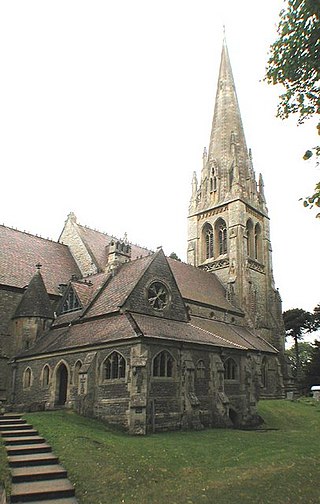
Henry Woodyer (1816–1896) was an English architect, a pupil of William Butterfield and a disciple of A. W. N. Pugin and the Ecclesiologists.
William Willmer Pocock was a British architect.
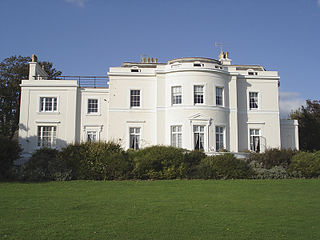
Worthing, a town with borough status in the English county of West Sussex, has 212 buildings with listed status. The Borough of Worthing covers an area of 8,030 acres (3,250 ha) on the south coast of England, facing the English Channel. The town's development in the early 19th century coincided with nearby Brighton's rise as a famous, fashionable resort, and Worthing became a quiet seaside town with a large stock of Victorian buildings. Residential growth in the 20th century absorbed nearby villages, and older houses, churches and mansions became part of the borough. The Town and Country Planning Act 1947, an act of Parliament effective from 1948, introduced the concept of "listing" buildings of architectural and historical interest, and Worthing Borough Council nominated 90 buildings at that time. More have since been added, but others have been demolished. As of 2009, Worthing has three buildings of Grade I status, 11 listed at Grade II*, 196 of Grade II status and three at the equivalent Grade C.
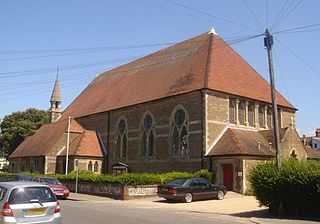
St George's Church is an Anglican church in the East Worthing area of the borough of Worthing, one of seven local government districts in the English county of West Sussex. Built in 1867–68 to serve new residential development in the southeast of the town, the Decorated Gothic-style structure was extended later in the 19th century, and expanded its reach further by founding three mission halls elsewhere in Worthing. English Heritage has listed it at Grade C for its architectural and historical importance.
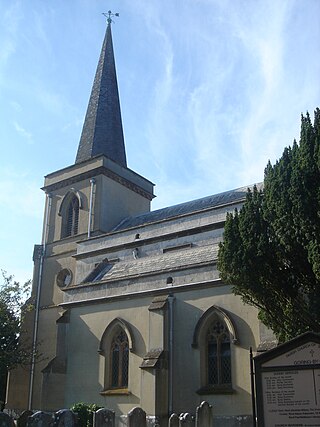
St Mary's Church is an Anglican church in the Goring-by-Sea area of the Borough of Worthing, one of seven local government districts in the English county of West Sussex. The late Norman parish church of the ancient village of Goring retains some architectural elements from that period, but Decimus Burton's comprehensive restoration of 1837 has given the church its present Gothic Revival exterior appearance. German artist Hans Feibusch, who worked extensively in the Diocese of Chichester, provided a mural in 1954: it is considered impressive, but caused controversy at the time. English Heritage has listed the church at Grade II* for its architectural and historical importance.

St Botolph's Church is an Anglican church in the Heene area of the borough of Worthing, one of seven local government districts in the English county of West Sussex. It had 11th-century origins as a chapelry within the parish of West Tarring, but declined and fell into disuse by the 18th century. Neighbouring Worthing's rapid development as a seaside resort in the 19th century encouraged residential growth around the ancient village of Heene, and a new church with the same dedication was built to serve both Heene and the high-class planned estate of West Worthing. Edmund Scott's Early English Gothic-style church stands next to the fragmentary ruins of the old church, which are listed separately at Grade II.
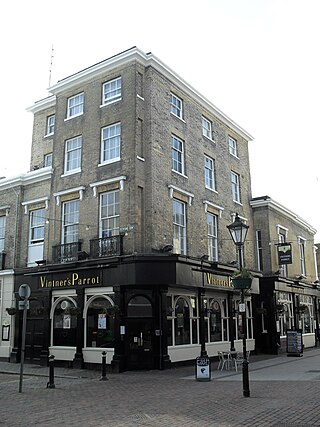
The Thieves' Kitchen is a pub in the centre of the town and borough of Worthing, West Sussex. Established as a public house in the late 20th century, it occupies two early 19th-century listed buildings in the oldest part of the town: a Greek Revival-style former wine merchants premises, and a Neoclassical chapel built for Wesleyan Methodists in 1839. The main part of the pub is in the wine merchants building facing Warwick Street, while the old chapel, facing Bedford Row, serves as its function room. Both buildings have been designated separately as Grade II Listed Buildings.

Ebenezer Particular Baptist Chapel is a former Strict Baptist place of worship in Hastings, East Sussex, England. Founded in 1817 by members of the congregation of an older Baptist chapel in the ancient town, it was extended several times in the 19th century as attendances grew during Hastings' period of rapid growth as a seaside resort. It was closed and converted into a house in the late 20th century, but still stands in a prominent position in Hastings Old Town. English Heritage has listed the building at Grade II for its architectural and historical importance.

Hastings Fishermen's Museum is a museum dedicated to the fishing industry and maritime history of Hastings, a seaside town in East Sussex, England. It is housed in a former church, officially known as St Nicholas' Church and locally as The Fishermen's Church, which served the town's fishing community for nearly 100 years from 1854. After wartime damage, occupation by the military and subsequent disuse, the building was leased from the local council by a preservation society, which modified it and established a museum in it. It opened in 1956 and is now one of the most popular tourist attractions in the town and borough of Hastings. The building, a simple Gothic Revival-style stone chapel, has been listed at Grade II by English Heritage for its architectural and historical importance.

St Leonard's Baptist Church is the Baptist place of worship serving St Leonards-on-Sea, a town and seaside resort which is part of the Borough of Hastings in East Sussex, England. The elaborate building was designed by the architectural firm of Thomas Elworthy, responsible for many churches in late-Victorian era Sussex, and serves the residential hinterland of St Leonards-on-Sea—an area which grew rapidly after its early 19th-century founding by James Burton. English Heritage has listed the church at Grade II for its architectural and historical importance.

St Mary Magdalene's Church is a Greek Orthodox place of worship in St Leonards-on-Sea, a town and seaside resort which is part of the Borough of Hastings in East Sussex, England. Dedicated to Mary Magdalene and built in 1852 for Anglican worshippers in the growing new town of St Leonards-on-Sea, a seaside resort which had been laid out from the 1820s, the church's prominent position on the skyline overlooking the town was enhanced in 1872 by the addition of a tower. No longer required by the Anglican community in the 1980s, it was quickly bought by the Greek Orthodox Church and converted into a place of worship in accordance with their requirements. The alterations were minimal, though, and the building retains many of its original fittings and its "archaeologically correct Gothic" exterior which reflected architectural norms of the early Victorian era. English Heritage has listed the church at Grade II for its architectural and historical importance.

East Worthing is a residential area of Worthing in the Worthing district, in the county of West Sussex, England, situated immediately to the east of Worthing town centre. It is bounded by the West Coastway railway line and Broadwater to the north, Brooklands Park to the east, Homefield Park and Worthing town centre to the west and the English Channel coast to the south.

The Tomb of Charles Spencer Ricketts is located in Kensal Green Cemetery in the Royal Borough of Kensington and Chelsea, London, England. It commemorates Commander Charles Spencer Ricketts, an officer in the Royal Navy. Designed in 1868 by William Burges, the tomb is a Grade II* listed structure.
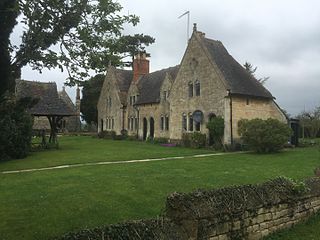
The Yorke Almshouses, Nos. 14–17 Church Row, Forthampton, Gloucestershire, England, are a range of four almshouses designed by the architect William Burges in 1865. The block is a Grade II listed building and the almshouses remain private residences.

The Cerberus Privy, at Gayhurst House, Buckinghamshire, England, is a communal lavatory built for the male servants of the house. It was constructed between 1859-1860 and was designed by William Burges. Now converted to a private home, it is a Grade II* listed building.

All Saints' Church is an active parish church in the village of Grayswood, Surrey, England. The church stands in the centre of the village and was built between 1900 and 1902. Designed by the Swedish artist Axel Haig, who lived in the village and is buried in the graveyard, the church is a Grade II listed building.


















